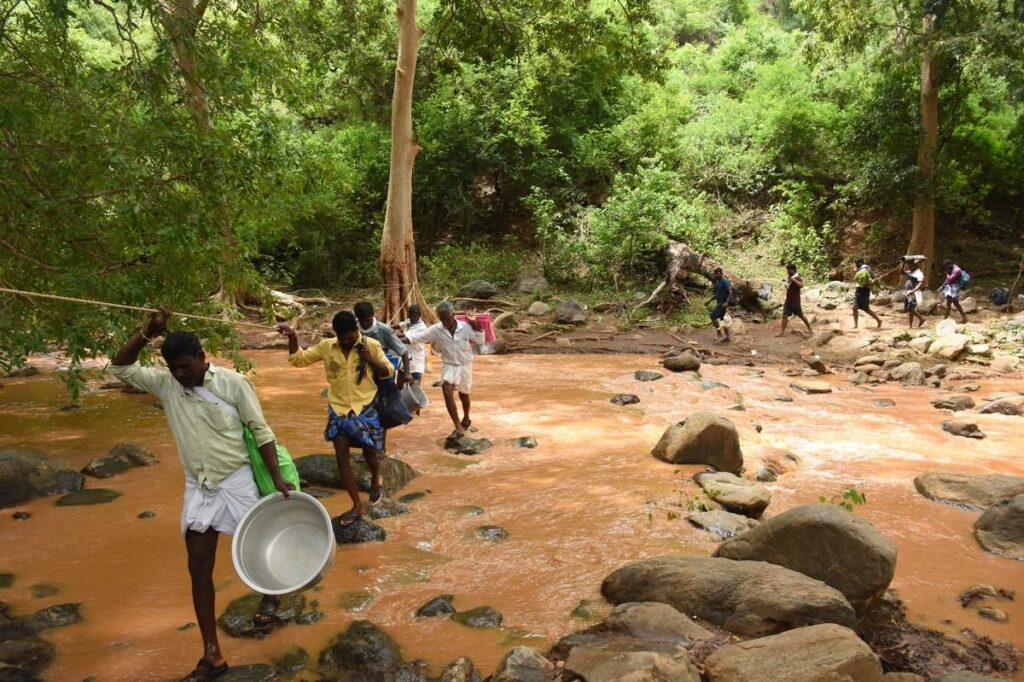For a pilgrim visiting Sri Maasi Kariya Bantan Ayyan Thiru Kovil, an Adivasi temple deep inside the crucial tiger and vulture habitats of Mudumalai Tiger Reserve (MTR), the journey involves a nearly hour-long bus ride from Udhagamandalam to Vazhaithottam in the MTR buffer zone.
At that point, there is a forest check post to cross before accomplishing about 10 km by car through poorly damaged roads and rock paths leading to Adicombai camp.
The next part of the exhausting journey is going down on foot for slightly longer than 2 kilometers. It will involve descending over 1000 feet of altitude by worshippers who will have to negotiate sheer cliffs and loose sand before they come across Kedarhalla River which must be crossed for them to reach this shrine. Although it is less than five kilometers there and back from Adicombai to the Temple, it takes most devotees over three hours due to the rugged terrain which is prone to falls and injuries.
In recent years, however, people from other parts of Tamil Nadu as well as Karnataka’s Gundlupet region have been making their way here; previously, only Badagas’ and Adivasis had access. The number of followers has grown since then as estimated by local senior citizens and Forest Department from between 500-1000 people during 1980s till the early 2000s into around10-15 thousands people on any given day in year 2024.
There are also other temples festivals held within this reserve such as those in Anaikkaty, Bokkapuram and Siriyur which again witness an exponential increase in visitors every year at a cost of increased habitat degradation for wildlife species including pollution of regional water resources.
On Tuesday June 18th , 2024 Selvi Mahesh along with her family, from Udhagamandalam in the Nilgiris, were on their way to the temple for the third time. “My husband and I are visiting this temple for the past three years with our family. Our friends advised us about it because they had made a trip there earlier,” she stated, adding that more people came here during the last three years of her visits.
Another devotee, Raj, from Gundlupet, said that the Maasi temple has become more commonly known in Karnataka in recent years. “It’s part of getting to it; only those who travel through hardship would have their prayers answered,” he added while explaining that over 20 relatives and friends accompanied him for this visit.
Calls for limited numbers
In Mudumalai Tiger Reserve (MTR), which is a critical area for threatened as well as endangered faunal species like elephants, tigers, vultures and striped hyenas due to its location within a crucial buffer zone encroached by temples; conservationists operating around have therefore proposed that the government limit visitors’ number during annual gatherings to protect these animals from human population pressure.
The Maasi Kovil temple festival, according to N. Mohanraj of Nilgiris, used to be attended by the local communities alone. “However, in recent years, non-Adivasi groups have started taking part in great numbers annually aggravating already existing pressures on wildlife in the area,” he said.
N. Mohanraj said that regarding animals like tigers which are vital for the region, there were numerous of them living around Maasi temple area. “Its construction was made along a corridor that allowed humans and other beings from crisscrossing between today’s Kerala, Karnataka, and Tamil Nadu. The same corridors still exist for wildlife,” said Mr. Mohanraj.
Jean-Philippe Puyravaud from Segur Nature Trust agrees with this view and notes that this region plays a critical role in ensuring connectivity and genetic dispersal between wildlife populations of Eastern and Western Ghats.
“Although this area has many tigers and elephants; it should be noted that these are also their last bastions against species that are on the verge of being lost locally such as three resident species of critically endangered vultures as well as striped hyena whose population – according to Forest Department estimates – does not exceed 30 individuals,” explains Mr. Puyravaud.
Water pollution
Mr. Mohanraj adds that apart from affecting wildlife; massive numbers of people visiting the temple every year have serious implications by causing depletion of water resources besides posing diseases risk to animals within its environs. For instance on Tuesday alone over one hundred goats were sacrificed at the temple whose carcasses were washed within stream waters. In addition, there is lack of toilets at the premises making worshippers defecate into river or nearby forests.“There are several diseases which can be spread through human waste,” added Mr.Mohanraj while pathogens may be carried downstream where they could influence drinking water dependent wildlife.”

According to members of the temple management committee which organizes the festival every year, the number of devotees has increased significantly. D. Krishnan who still remembers being part of this event during his childhood said that more than 10,000 persons visit the temple in two days each year.“Previously it would only be local members numbering maybe between five hundred and one thousand people,” he added.
Nevertheless, Krishnan among other members of a management committee such as B.Bommarayan and M.Mani do not share conservationists’ concerns arguing that “outsiders” are allowed to camp inside the forest for just one night since the temple festival is held once in a year. For instance, “We also conduct clean- up after completion of festival,” said Mr.Bommarayan stating that he believed it was discrimination against non-Adivasis when they were denied entry to this place.
“We also have an utmost respect for forests where we don’t allow alcoholic drinks into our midst; never pass there after darkness or during explosions when we are completely banned from setting fireworks,” says M. Mani.
However, it is argued by conservationists that temple festivals in the area increase already existing pressures on wildlife throughout the year with the road cutting through MTR. “The pressures add up, with temple festivals in Anaikatty, Siriyur, Bokkapuram and the Maasi temple attracting lakhs of devotees who have very little understanding of the ecological importance of the region,” said Mr. Puyravaud.
On monday (june 17) night, protesting devotees who came to visit the temple from after dusk staged a protest at forest check-post demanding to be allowed into forests as they walk down to the temple which lies precariously below. Speaking during a recent interview with Forest Department top official stated that these measures are done for safety purpose but not followed by their attendees. However regulars also say that injuries along this route are common – an incident in 2022 revealing what really happens deep inside tiger reserves: when four people attending an event at nearby Anaikkal Mariamman Temple were swept away in flash floods.
Mr Mohanraj said that steps should be taken by both Forest Department and State government to cap visitors to temples so as limit capacity and prohibit private vehicles from entering the reserve past forest check-post “The Forest Department can operate their own vehicles to take devotees to Adicombai. This will likely lead to fewer people visiting,” he said adding non-tribals without a connection to the temple should be banned from coming in large numbers also “An e-pass system, which allows only a fixed number of devotees can also be considered,” he said.
“Temple-tourism within protected areas must therefore have specific laws or rules regulating such activities and conservationists especially ecologists should be heard by The Forest Department and State government. Not only does over-exploitation disturb wild animals but it results otherwise too.” There is usually such a widely held belief among the locals that a high number of tigers and elephants is indicative of well-being within natural ecosystems, but this has been accompanied by similar decreases in other species such as hyenas and vultures while all these trends are linked to anthropogenic influences leading to their decline. There might be links between temple tourism, as well as other human activities across the region and this,” said a Tamil Nadu based conservationist who would not disclose his identity.







